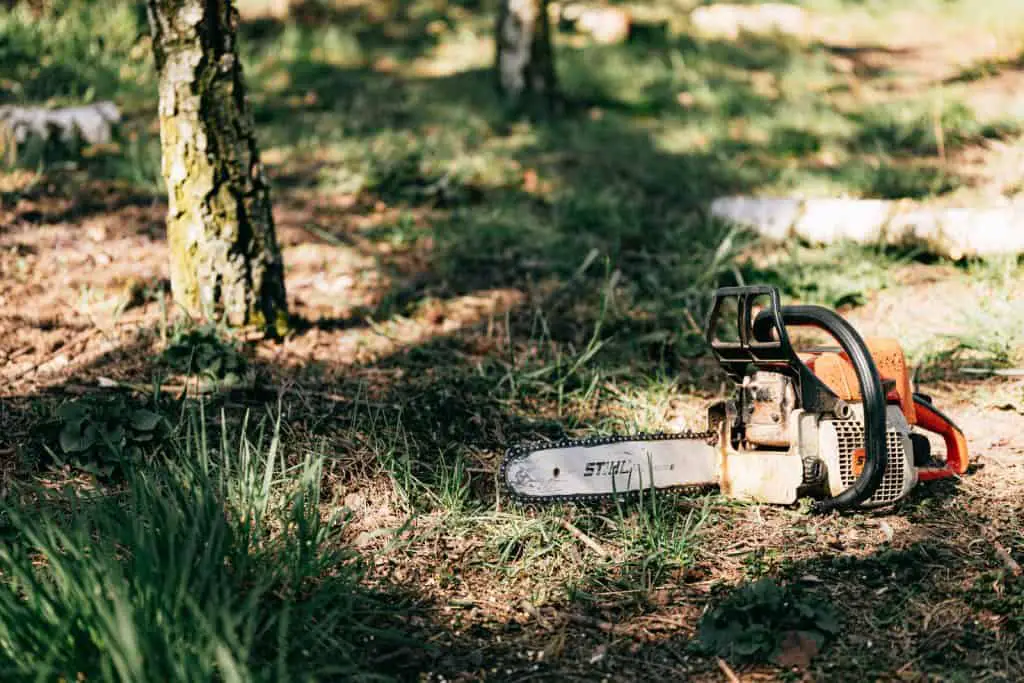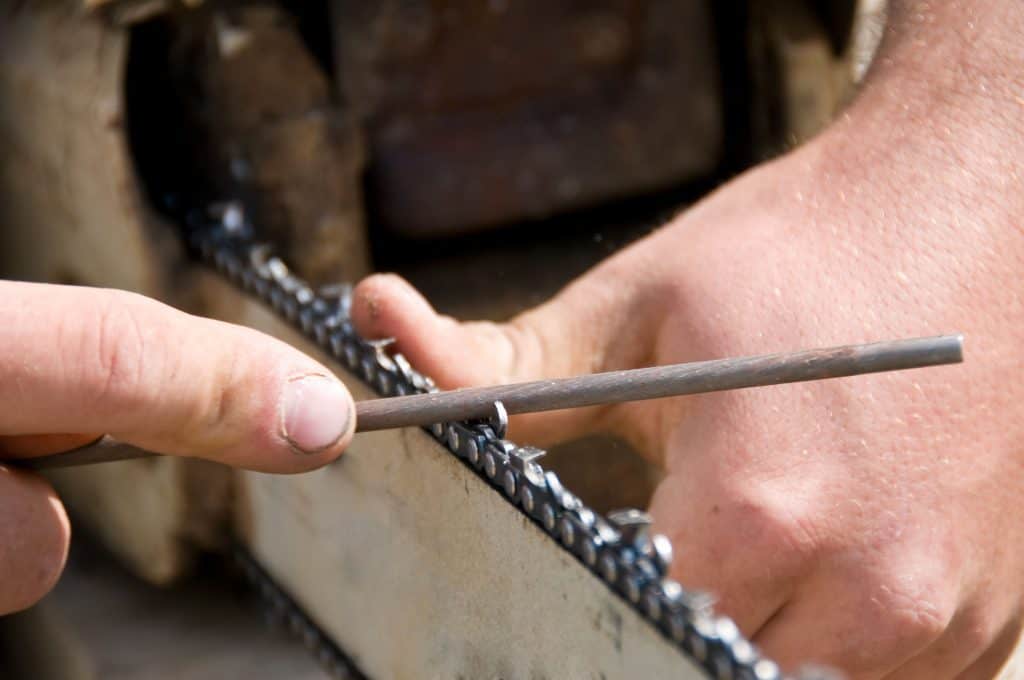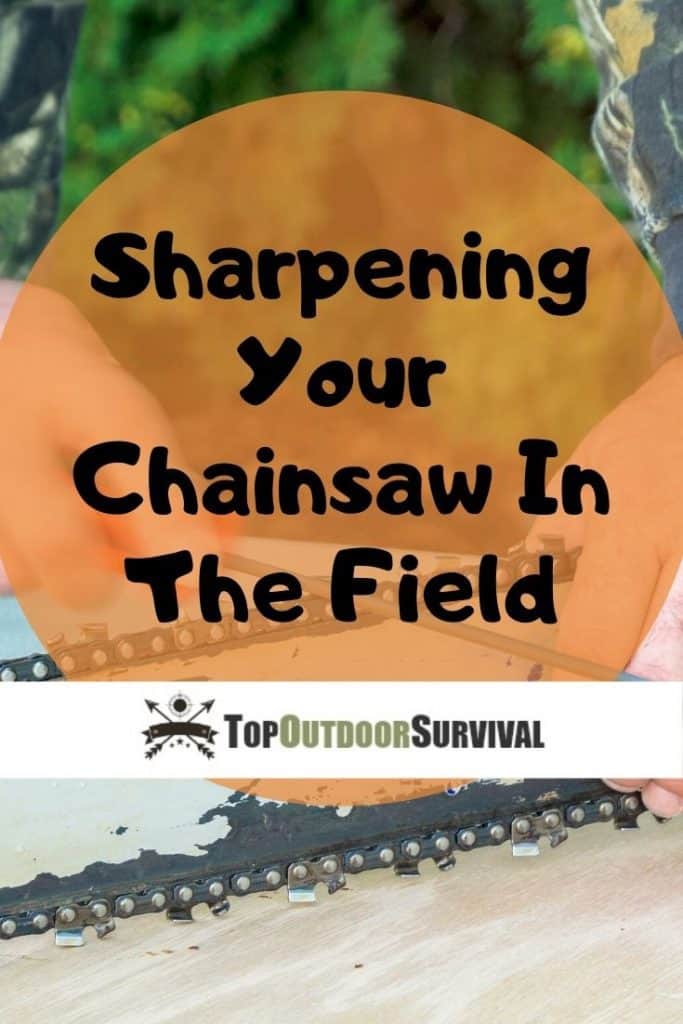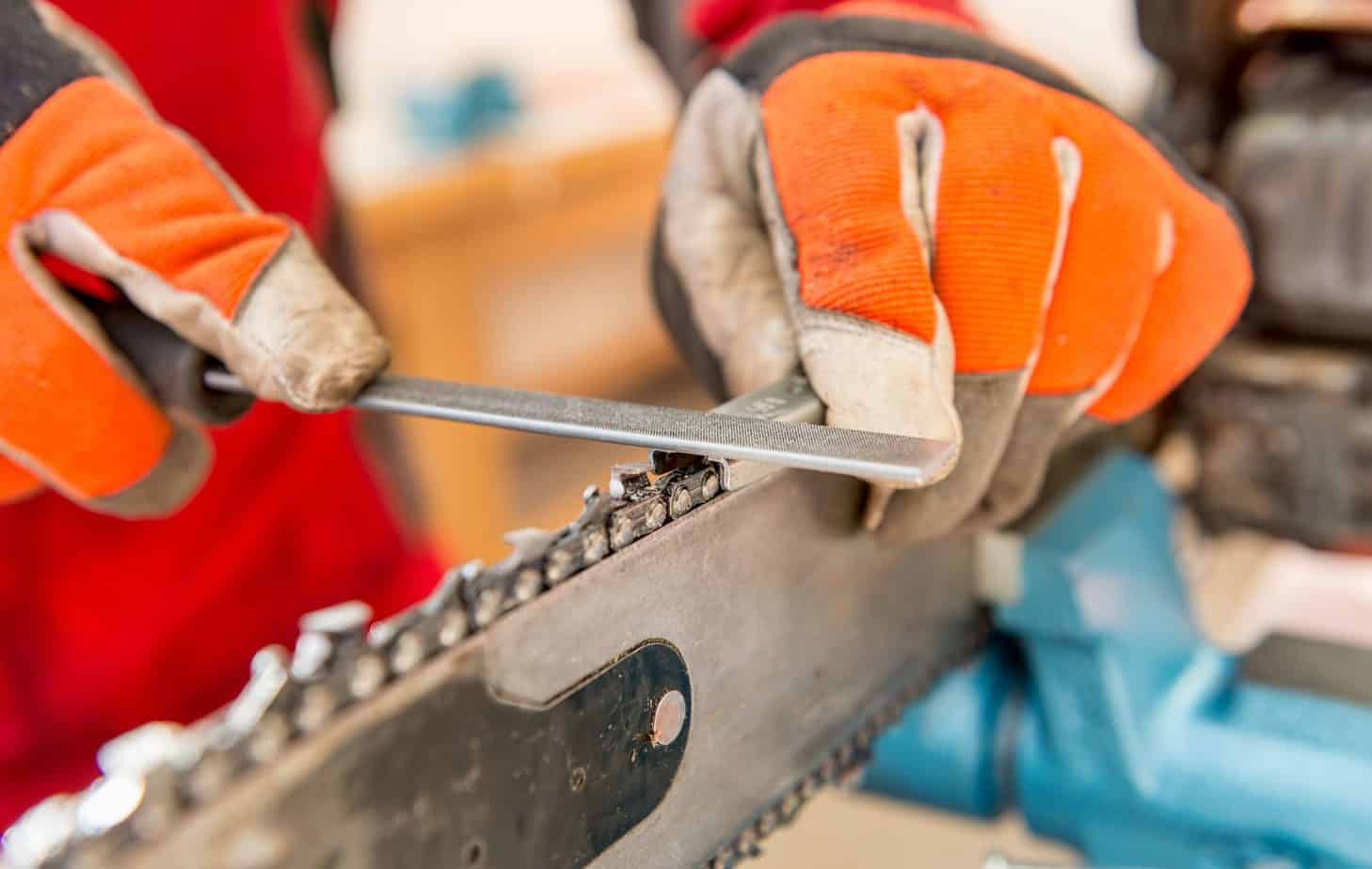It is not uncommon for circumstances to arise in which a chainsaw chain needs to be sharpened in the field. Fortunately, there are a host of tools that can be utilized to safely sharpen a chainsaw while in the field.
How do I sharpen my chainsaw in the field? There are a few ways to sharpen your chainsaw while you are in the field. The most effective ways to sharpen a chainsaw in the field include:
- Using A Sharpening File
- Using A Grinder Sharpener
- Using A Rotary Sharpener
In this article you will learn about the types of chainsaw sharpeners that are ideal for use in the field. You will also learn how to use a file to sharpen your chainsaw and how to store and maintain your chainsaw equipment while you are in the field.
The Importance Of Understanding The Parts Of A Chainsaw Chain

Before you proceed to using a chainsaw sharpener, you should first familiarize yourself with the function of each chain component. Otherwise, you certainly run the risk of sharpening the chain incorrectly. One of the most common mistakes that operators make involves reducing the height of the rakers to take a bigger bite out of wood.
If you aren’t aware of why this is a bad idea, you are not alone. I’ll cover the full details here. A description of the chainsaw chain components starts out with the “front” part of the chainsaw chain tooth.
The raker is positioned at the front of each tooth. There is a chasm between the top plate of the tooth and the raker. The size of the raker will determine just how big of a bite the teeth take out of the wood. Some operators will purposely reduce the size of the raker, as to be able to remove more wood with each tooth of the chain.
Reducing the size of the raker is a bad idea because it will actually put unnecessary strain on the chainsaw chain. The chain’s speed of travel will be reduced and the chainsaw will become much more dangerous to operate. To determine the height of the raker, you should look for a raker depth gauge. Most file sharpening kits will include a raker depth gauge as part of the kit.
The other components of a chainsaw chain tooth include:
- Slide Plate: this is located on the opposite side of the tooth relative to the raker.
- The slide plate should be perpendicular to the base of the tooth. If it is not straight up and down, then kickback of the saw is likely to occur
- Top Plate: this is the flat top at the back of the tooth, it needs to be angled 20-35 degrees to set the required width of the saw kerf
- Point: this where the slide plate and top plate meet. This is the portion of the tooth that actually starts the cut. You will also hear this part being called the cutting corner.
- Chisel Angle: This is the part of the tooth that is positioned directly beneath the top plate. The angle should be set at 45 to 55 degrees so that chips are able to slide underneath the tooth.
For the visual learners, there are many good diagrams and illustrations showing the components of chainsaw chain teeth. Looking at the illustration found here, you can get a better feel for what is meant by “reducing the size of the raker”.
How Do I Know That My Chainsaw Needs To Be Sharpened?

There are numerous telltale signs that indicate that it is time to sharpen your chainsaw. Chief amongst these is an obvious dip in the performance of the chain. Being cognizant of changes in the performance of your chainsaw will help you avoid injury risk.
Signs that your chainsaw needs to be sharpened include:
- The chainsaw is producing crooked cuts
- Fine sawdust is emitted rather than chips of wood
- You find yourself having to apply more pressure
- You notice the smell of burnt wood as you cut
The least obvious of these signs is the burnt wood smell. While you are working in the field, you are likely to ascribe the burnt wood smell to a variety of sources other than your chainsaw chain. It could very well be the result of your chainsaw chain not cutting through the wood cleanly.
How Often Do I Need To Sharpen My Chainsaw?
The telltale signs of a dull chainsaw chain are listed in the section above. It is best to not wait until the chain is clearly dull before operating it. The life expectancy of a chainsaw chain depends largely upon the type of material that you are trying to cut through. Some types of trees are known for being easy to cut through, while others are not.
Though there is not a universal life expectancy for chainsaw, you can still take steps to be proactive. You are encouraged to inspect your chain before each use. Even the most minor of deformities in a chainsaw chain can lead to bigger problems down the road. These deformities can cause you to maneuver your chainsaw in a way that you wouldn’t normally. An example of this would be holding the saw differently because the chain is producing a crooked cut.
What to look for when you inspect your chainsaw chain before each use:
- Damaged or over-worked links
- Damaged or over-worked teeth
- The top plate of the cutting teeth should be at least ¼” in length
- The top plate of a cutting tooth is the flat surface at the top of the tooth
If the chainsaw chain shows the above signs of wear and tear, then the chain should be discarded. Otherwise, you will be able to proceed to sharpening the chain. It’s always a good idea to sharpen your chain if you have not used your chainsaw in several weeks or more.
If you use your chainsaw less frequently, you may have a hard time being able to tell that the chain needs sharpening. Those who use their chainsaws quite regularly have a better feel for when the chain needs to be sharpened.
Why You Need To Use A Vice
You are encouraged to always make use of a vice when sharpening a chainsaw chain. The vice should secure the bar of the chainsaw. Not using a vice to brace the chainsaw can result in uneven sharpening, as it is critical to be able to have the proper leverage while sharpening. It also represents a safety hazard.
Finding a vice for the field is not as difficult as you may think. There are products on the market that are specifically designed for the chainsaw operator who has no choice but to sharpen their saw while out in the field.
One such product is the Oregon Chainsaw Filing Vice. This vice weighs only 10 ounces and includes forks that can be driven into a stump. Thanks to the compact size of this vice, it can be easily put in a backpack. Some vices can be a real chore to haul from site to site while in the field. That is certainly not the case with this vice.
You can even find a chainsaw file sharpening kit that includes a stump within the kit. This is the case with the Cataumet Chainsaw Sharpening File Kit. The kit also includes the necessary round and flat files, as well as a felling wedge for trees. All of these tools are packaged together in a large field bag that has handles at the top for simple transport. The total weight of the item is 2.63 pounds.
Ways To Sharpen A Chainsaw Chain
There are many ways to sharpen a chainsaw chain, some methods are more practical for use in the field than others. The most common way to sharpen a chainsaw in the field is to use a sharpening file kit, as will be discussed in further detail below.
Using a file to sharpen a chainsaw in the field can be tedious and time consuming though. For this reason, there exist portable electric chainsaw sharpeners that can be used in the field. Some of these chainsaw sharpeners run on lithium ion batteries, while others have the ability to be connected to a vehicle battery.
Regardless of which chainsaw sharpener you use, you will need to ensure that your chainsaw is securely in place while you are sharpening it. Details on how to keep your chainsaw securely in place while you sharpen it will be provided in a section later in this article.
Sharpening File
One of the most convenient ways to sharpen your chainsaw in the field is by using a file. For one thing, a file is quite suitable for use in the field because it doesn’t weigh much and is not large enough to be a real burden to carry from place to place.
Another benefit of the sharpening file is the affordability of this tool. This claim is supported by the price tag on this Katzco Chainsaw Sharpener File Kit. The chainsaw sharpener kit includes fine tooth flat files and a variety of round files sized 5/32”, 3/16”, and 7/32”. The kit also includes a depth-gauge tool. Perhaps the greatest feature of this specific kit is the hardwood handle that could be attached to any of the files.
If there is a downside to using a sharpening file, it may be the learning curve associated with using this using this tool to its full capability. If you do not get the technique down to a tee, you will run the risk of not sharpening each tooth of the chain evenly. This could cause a pretty significant dip in the performance quality of the chainsaw chain.
Fortunately, there are a lot of educational resources available for those who are new to using a sharpening file. One such educational resource is this handout from Michigan State University entitled “Things You Should Know About Your Chainsaw”. Properly sharpening with a file involves starting out by either setting your chainsaw on a flat surface or by clamping the bar of your chainsaw in a vice.
Either way, you will need to set the chainsaw securely in a way that will allow the chain to rotate freely while you are sharpening it.
Here is how to sharpen your chainsaw chain using a file:
- Identify the leading cutter of the chain, this will be the shortest cutter on the chain
- It is possible that all cutters appear to be of the same length, in this case you can start out anywhere
- Mark the first cutter that you sharpen with either white out or a permanent marker
- Look for the notch at the front of the cutter (appears as an angled tooth) and set the file in the notch
- The curve of the file should match the curve of the tooth, the top of the file should be nearly flush with the top of the cutter
- The standard angle is 25 degrees but a ripping chain will have a flatter angle
- The file should be slid across the cutting face so that metal filings are discharged
- Proceed to work each tooth with the same angle
- Reverse the sides of the saw in order to file all of the teeth angled in the opposite direction
How To Store Your Sharpening Files
Avoid freely placing your files in your pockets or in a backpack. The sharpening files should be stored in a secure location for both safety purposes and maintenance purposes. If they are not stored properly, the sharpening files can become damaged quite easily.
Any pouch on a tool bag would be an excellent location for a sharpening. You may be trying to minimize the size of the tool bag that you take out into the field with you. In that case, you will still find plenty of options available.
Many file sharpening kits will come with tool pouches, as is the case with this kit. If not, you can always use a tool pouch made for carpenters and electricians, such as this ECOmorning Canvas Tool Pouch Bag. This tool pouch has an adjustable weight strap, making it simple to Cary your file sharpener kit while you are out in the field.
Lithium Battery-Powered Portable Chainsaw Sharpener Grinder
A quicker way to sharpen your chainsaw in the field is to use a portable chainsaw sharpener that is powered by a battery. Such a system will require much less manual labor than a sharpening file that you will have to maneuver across the length of the chain in a way that allows each cutter to be sharpened evenly.
The SuperHandy Chainsaw Sharpener is powered with a lithium battery for use in the field. The grinder has an angle of 35 degrees left and right. While this is certainly a convenient tool to use to sharpen your chainsaw chain, the main concern with this tool may be the weight of the tool.
The SuperHandy Chainsaw Sharpener only weighs 3.75 lbs. This lightweight sharpener is easy to carry within a backpack, making it well-suited for use in the field. The sharpener can also be mounted on a workbench table or on the wall, so that it serves a wide range of uses both in the field and at home.
Plug-In Rotary Chainsaw Sharpener
Another type of portable chainsaw sharpener is seen with the MaiDa Electric Chainsaw Sharpening Kit. This portable chainsaw sharpener weighs just 1.54 lbs., making it simple to carry even the farthest of distances to a remote site. This sharpener is of the rotary sharpener variety while the SuperHandy Chainsaw Sharpener is a grinder-type chainsaw sharpener.
The downside to this sharpener is that you will need to plug-in to some kind of a power source to use this sharpener. As long as you have a reliable power source, this is an excellent tool for use in the field.
A Chainsaw Sharpener That Can Run Off A Vehicle Battery
You can also find chainsaw sharpeners that run off of a 12V vehicle battery. For example, this Blue Max Electric Chainsaw Chain Sharpener comes with clamps for the positive and negative terminals of your 12V vehicle battery. This sharpener will work with any round-ground chain of the most common chain pitch sizes.
This sharpener also includes sharpening stones of the following sizes:
- 5/32”
- 3/16”
- 7/32”
The sharpener also only weighs 0.9 lbs. This makes it one of the least heavy electric chainsaw sharpeners on the market.

Related Posts:
10 Types of Chainsaw Chains Explained
Can You Use a Chainsaw Without Bar Oil?
This is Why You Must Not Use A Chainsaw in the Dirt

